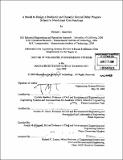A model to design a stochastic and dynamic ground delay program subject to non-linear cost functions
Author(s)
Hanowsky, Michael John
DownloadFull printable version (34.97Mb)
Other Contributors
Massachusetts Institute of Technology. Engineering Systems Division.
Advisor
Amedeo Odoni.
Terms of use
Metadata
Show full item recordAbstract
When inclement weather reduces the arrival capacity of a busy metropolitan airport, it may lead to significant airborne delays. Delaying aircraft in the air consumes additional fuel, increases overall air traffic congestion, and may lead to costly flight diversions. As a result, during periods of inclement weather, the FAA may implement a Ground Delay Program (GDP) to proactively delay flights on the ground before they depart and reduce the possibility of future airborne delays. However, in order to assign ground delays to flights, a GDP must be implemented before they depart, at a time when the future airport arrival capacity may be uncertain. This dissertation discusses two analyses in regards to the design of a GDP. The first analysis proposes a model that solves for the optimal assignment of ground delay to aircraft for a stochastic and dynamic forecast of the airport arrival capacity, with nonlinear delay cost functions, and a capacity of the airborne arrival queue. This model is applied to several hypothetical examples and, in comparison to prior models from the literature, identifies solutions with a lower total expected cost, a smaller maximum observed arrival queue, or both. The second analysis compares the salience, or importance, of various stakeholder groups to their roles in the design of a GDP in practice. Passengers, in particular, are shown to be an important, but under-represented stakeholder group. A second model is proposed that solves for an assignment of ground delay that minimizes the total passenger delay cost. A comparison of these results to those of the first model show that the total cost of delays to passengers could be reduced by more than 30% if the FAA were to directly consider the cost of delays to passengers during the design of a GDP.
Description
Thesis (Ph. D.)--Massachusetts Institute of Technology, Engineering Systems Division, 2008. Includes bibliographical references (p. 245-247).
Date issued
2008Department
Massachusetts Institute of Technology. Engineering Systems DivisionPublisher
Massachusetts Institute of Technology
Keywords
Engineering Systems Division.